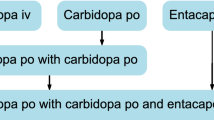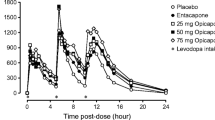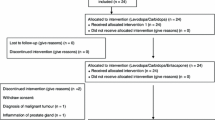Abstract
Objective: Entacapone is a peripherally acting catechol O-methyltransferase (COMT) inhibitor used as an adjunct to each daily levodopa/dopa decarboxylase (DDC) inhibitor dose in the treatment of Parkinson's disease. Parkinsonian patients with advanced disease and motor fluctuations take several doses of levodopa daily, due to the short action of levodopa in this patient population. The present study was conducted in order to evaluate the pharmacokinetics of entacapone after multiple dosing and the pattern of COMT inhibition in erythrocytes during the first day of dosing as well as during steady state. Furthermore, the disposition of plasma levodopa and carbidopa was studied after a single dose of levodopa/carbidopa during the same conditions.
Methods: Twelve healthy male volunteers received 200 mg entacapone eight times daily during study day 1 and day 6 at 2-h intervals from 0800 hours to 2200 hours. During days 3, 4 and 5, 200 mg of entacapone was taken ten times daily, from 0800 hours to 0200 hours on the following day. One levodopa/carbidopa tablet (100/25 mg) was taken on study day 1 and day 6 at 1000 hours. Plasma entacapone concentrations and erythrocyte COMT activities were measured frequently on study days 1–2 and 6–7, and twice daily on study days 3–5. Pharmacokinetic parameters calculated from plasma drug concentrations on days 1–2 and 6–7 were compared with each other.
Results: There were no differences in maximal plasma concentration (Cmax), time to maximal drug concentration in plasma (tmax), elimination half-life (t1/2) and area under the plasma concentration–time curve (AUC) of entacapone between day 1 and day 6. The mean t1/2 values of entacapone were 1.3 h and 1.8 h during the first and sixth days, respectively; the difference was not significant. No signs of accumulation of entacapone were noted after the first day. Entacapone reduced erythrocyte COMT activity after the first dose, and this effect was quite stable during frequent dosing. There were no indications of accumulation of COMT inhibition during frequent dosing of entacapone. There were no between-day differences in Cmax, t1/2 (2.4 h on days 1–2 and 2.3 h on days 6–7) or AUC of levodopa, whereas tmax occurred at 0.8 h on day 1 and at 1.2 h on day 6 (P = 0.03). There were no between-day differences in the pharmacokinetic parameters (Cmax, tmax and AUC) of carbidopa.
Conclusion: Even when dosed frequently, there are neither indications of accumulation of entacapone nor of its COMT inhibiting activity.
Similar content being viewed by others
Author information
Authors and Affiliations
Additional information
Received: 28 December 1998 / Accepted in revised form: 29 March 1999
Rights and permissions
About this article
Cite this article
Rouru, J., Gordin, A., Huupponen, R. et al. Pharmacokinetics of oral entacapone after frequent multiple dosing and effects on levodopa disposition. E J Clin Pharmacol 55, 461–467 (1999). https://doi.org/10.1007/s002280050657
Issue Date:
DOI: https://doi.org/10.1007/s002280050657




